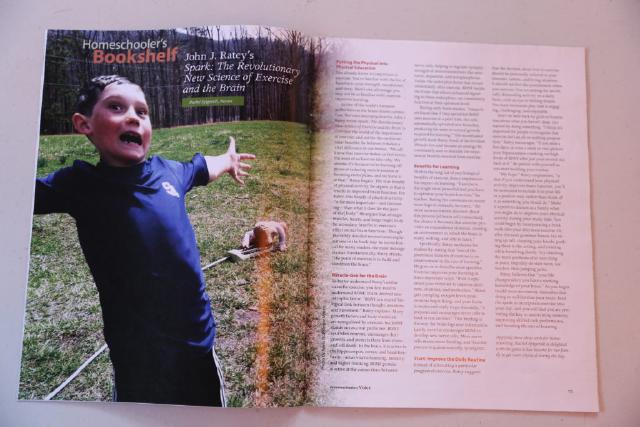As one of the world’s foremost authorities on the brain-fitness connection, Harvard neuropsychiatrist John Ratey wrote Spark: The Revolutionary New Science of Exercise and the Brain to convince the world of the importance of exercise, and not for the cardiovascular benefits; he believes it makes a vital difference in our brains.
“We all know that exercise makes us feel better, but most of us have no idea why. We assume it’s because we’re burning off stress or reducing muscle tension or boosting endorphins, and we leave it at that,”Ratey begins.
The true benefit of physical activity, he argues, is that it results in improved brain functioning. For Ratey, this benefit of physical activity “is far more important—and fascinating—than what it does for the body.” He argues that stronger muscles, hearts and lungs might truly be secondary benefits to exercise’s primary effect on our brain functions. Though the richly detailed neuroscience explanations in the book may be too technical for many readers, the main message is clear. Fundamentally, Ratey attests,
“the point of exercise is to build and condition the brain.”
Miracle-Gro for the Brain
To better understand Ratey’s enthusiasm for exercise, you first need to understand BDNF, brain-derived neurotrophic factor. “BDNF is a crucial biological link between thought, emotions and movement,” Ratey explains. Many growth factors and body chemicals are upregulated by exercise, but BDNF stands out as a star performer. BDNF nourishes neurons, encourages their growth, and protects them from stress and cell death. In the brain, it is active in the hippocampus, cortex, and basal forebrain—areas vital to learning, memory, and higher thinking. BDNF protein is active at the connections between nerve cells, helping to regulate synaptic strength of neurotransmitters like Serotonin, Dopamine and Norepinephrine. Unlike the endorphin boost that occurs immediately after exercise, BDNF builds the frame which allows enhanced signaling so these endorphins can consistently function more optimally. During early brain studies, “researchers found that if they sprinkled BDNF onto neurons in a petri dish, the cells automatically sprouted new branches, producing the same structural growth required for learning.” This accentuated growth made Ratey think of the fertilizer Miracle-Gro, and became an analogy he consistently uses to describe the exponential benefits received from exercise.
Benefits for Learning
Within the long list of psychological benefits of exercise, Ratey especially emphasizes the impact on learning.
“Exercise is the single most powerful tool you have to optimize your brain function,” he teaches.
Basing his comments on recent neurological research, he states, “the more neuroscientists discover about this process [of brain cell connection], the clearer it becomes that exercise provides an unparalleled stimulus, creating an environment in which the brain is ready, willing, and able to learn.” Specifically, Ratey motivates his readers by stating, “one of the prominent features of exercise is an improvement in the rate of learning.” He goes on to describe more specifics. Exercise improves your learning in three important ways. “First it optimizes your mind-set to improve alertness, attention, and motivation.” Blood gets pumping, oxygen levels peak, neurons begin firing, and your brain is awake and ready to go. Secondly, “it prepares and encourages nerve cells to bind to one another.” This binding is the way the brain logs new information. Lastly, exercise encourages BDNF to develop new nerve cells. More nerve cells means more binding, and thus the process is quintessentially synergistic.
Start: Improve the Daily Routine
Instead of advocating a particular program of exercise, Ratey suggests that the decision about how to exercise is very individual. The program should be personally tailored to your interests, talents and living situation. It should not feel like punishment when you exercise. You are aiming for aerobically demanding activity on a daily basis, with an eye to lifelong fitness. You want strenuous play that is engaging, challenging, and enjoyable. Don’t be held back by guilt or frustration about what you haven’t done. Get started by doing something.
“I think it’s important for people to recognize that exercise isn’t an all-or-nothing proposition,” Ratey encourages. “If you miss a few days, or even a week or two, picture your hippocampus cranking out high levels of BDNF after just your second day back at it.”
Be patient with yourself as you start building your routine. “My hope,” Ratey emphasizes, “is that if you understand how physical activity improves brain function, you’ll be motivated to include it in your life in a positive way, rather than think of it as something you should do.” Make it a point to discuss as a family what you might do to improve your physical activity during your study time. You could begin by incorporating a brisk walk into your afternoon routine. Or, after the next grammar lesson, try sitting up tall, clasping your hands, pushing them to the ceiling, and twisting, breathing slowly. Try checking the math problems after marching in place. Impishly do stair races, toe touches, then jumping jacks. Ratey believes, “your life changes when you have a working knowledge of your brain.” As you begin to add more movement, remember that doing this will fertilize the brain. Feed the spark to incorporate exercise into your day, and you will find you are providing the key to maintaining memory, improving skilled task performance, and boosting the rate of learning.
originally published in June 2017 VOICE
